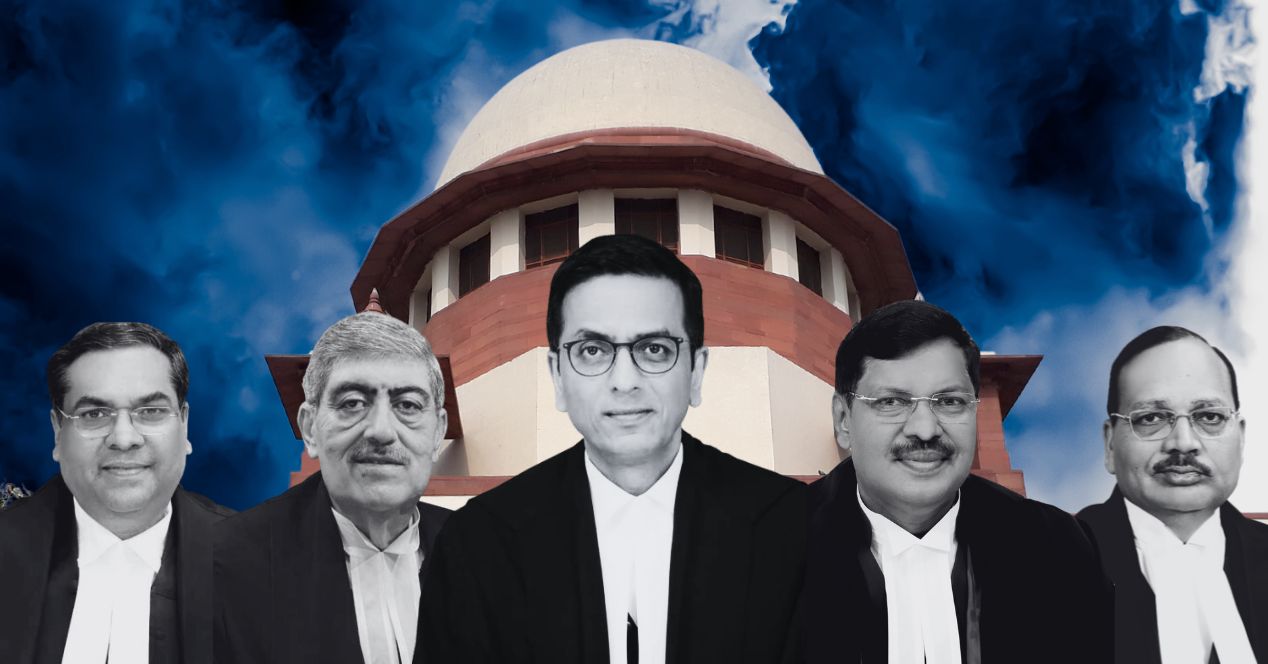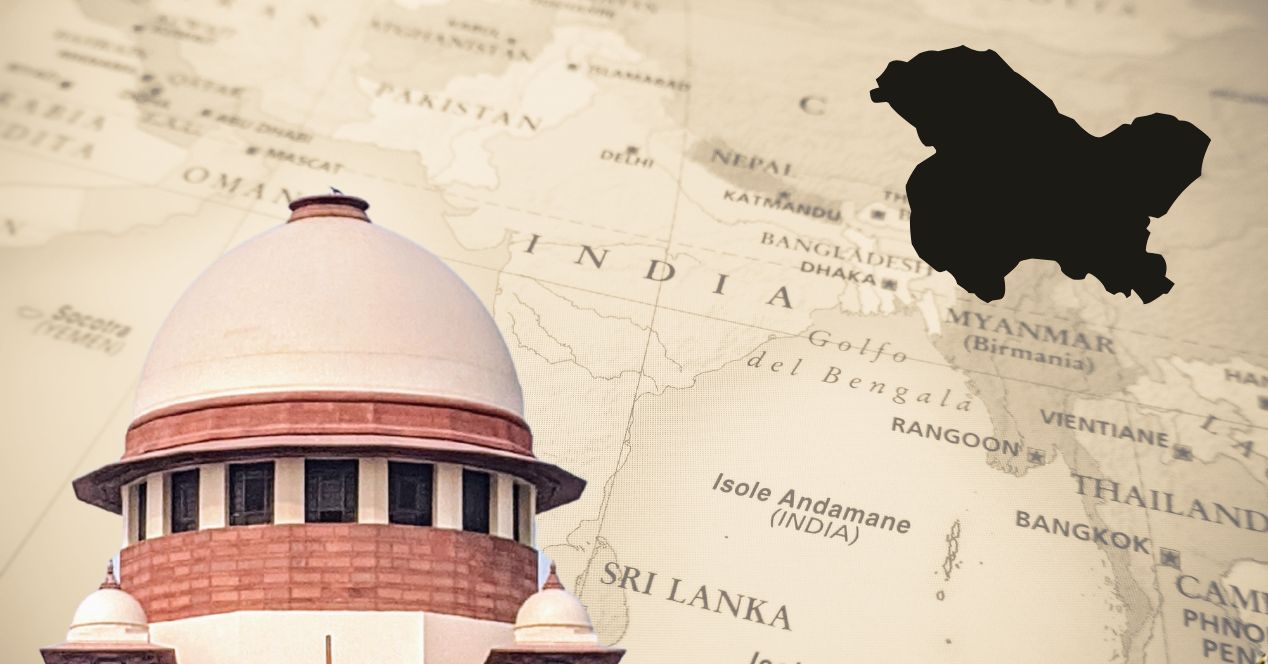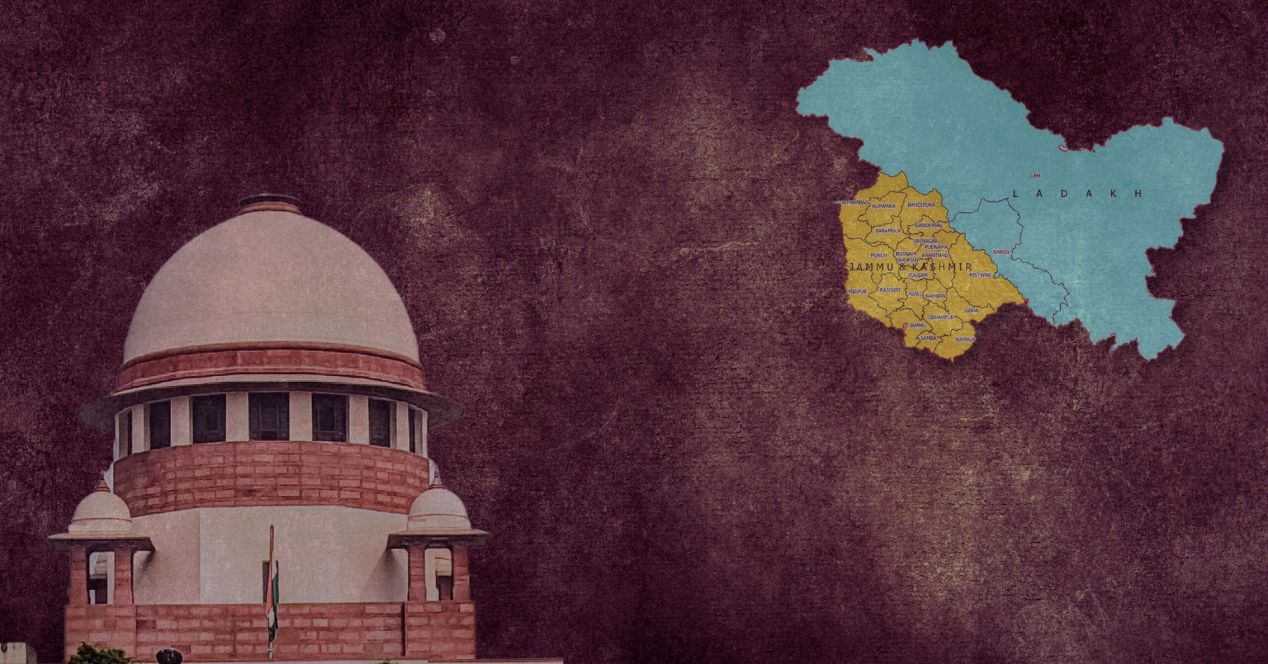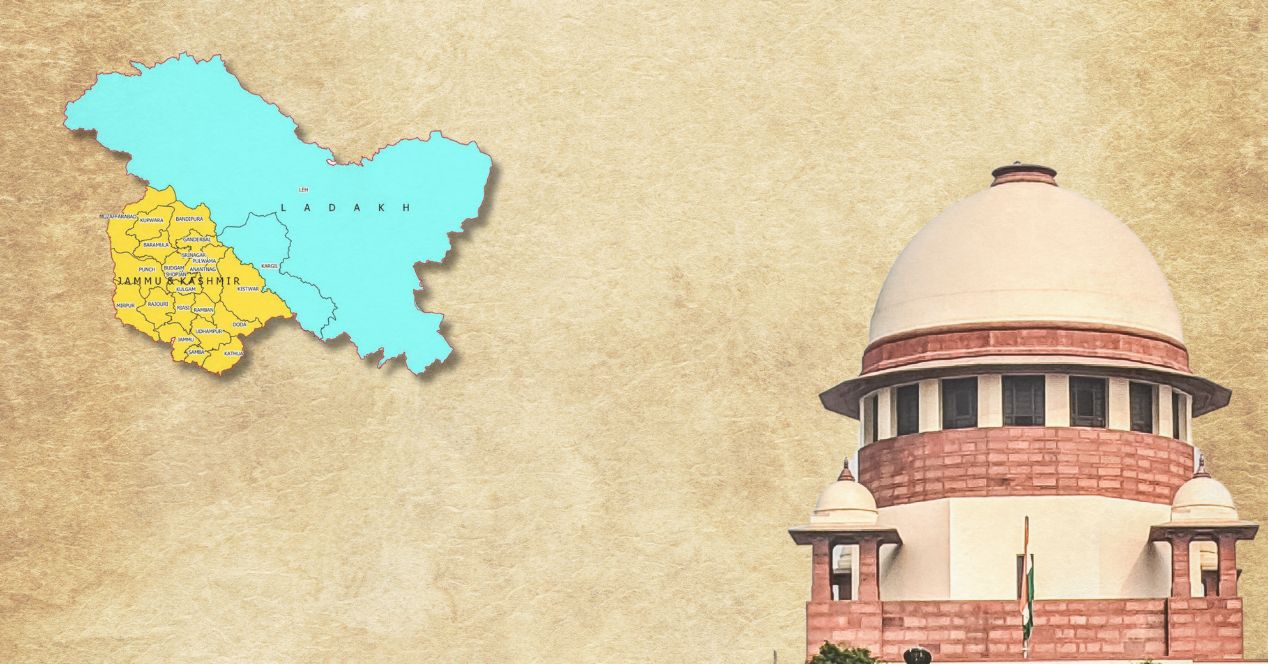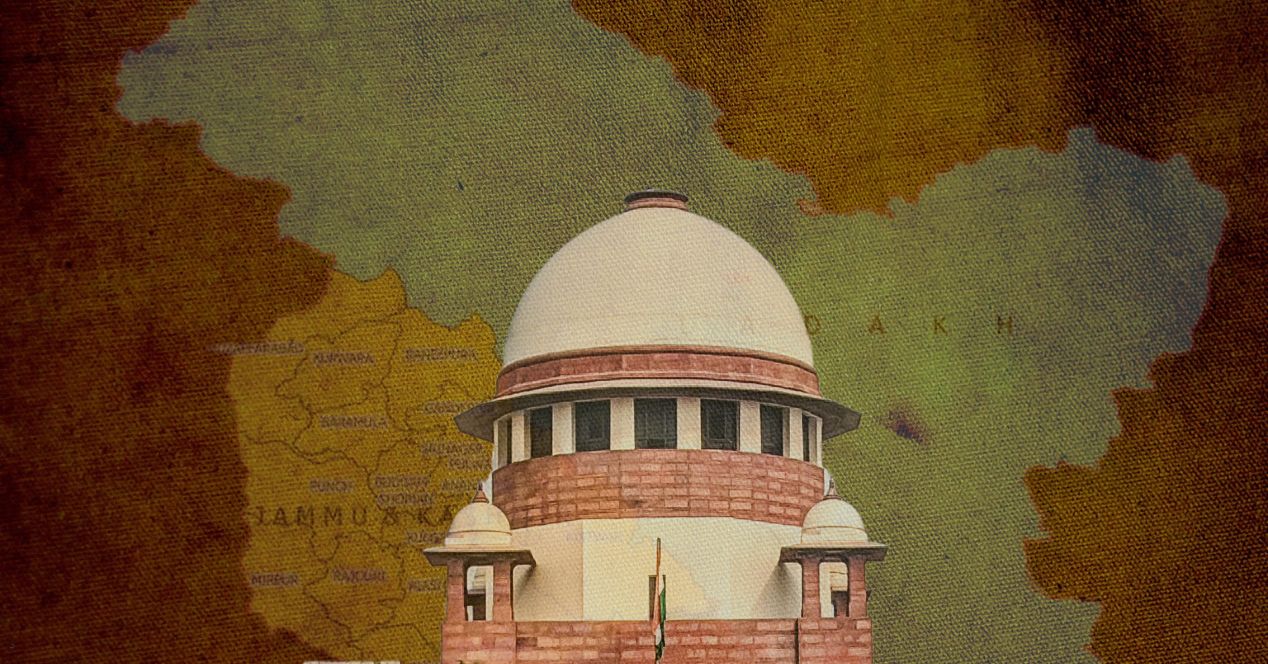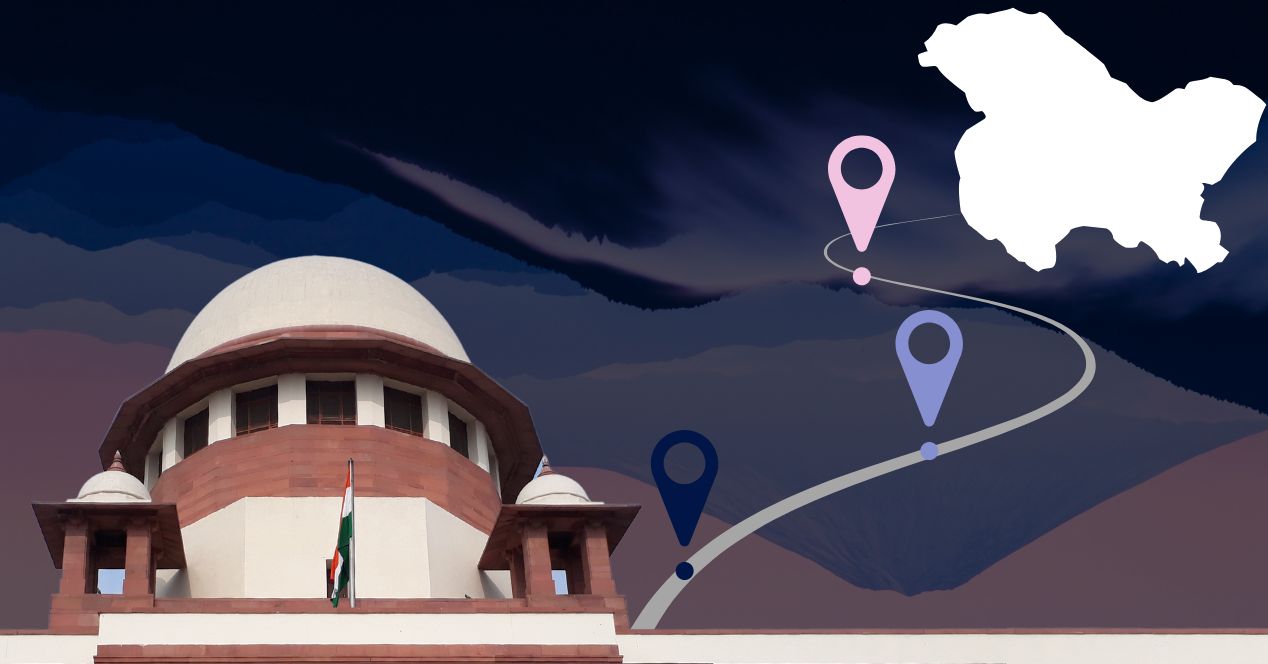Abrogation of Article 370 | Day 9: What makes the relationship between India and J&K binding, asks CJI
Challenge to the Abrogation of Article 370Judges: D.Y. Chandrachud CJI, S.K. Kaul J, Sanjiv Khanna CJI, B.R. Gavai J, Surya Kant J
Today, the Bench heard arguments from eight counsels appearing for the petitioners.
Senior Advocate Nitya Ramakrishnan argued that Article 370 was a sui generis power vested with J&K. Senior Advocate Menaka Guruswamy argued that the provision reflected the constitutional intention to offer a “unique brand of federalism” to J&K.
Senior Advocate Gopal Sankaranarayanan argued after lunch till the close, focusing on filling the gaps in the arguments made so far. He stated that Article 370 was always designed to be permanent, and that a “meeting of minds” between J&K and India was crucial to consider any modifications to that provision, including its abrogation.
Background
Article 370 of the Constitution of India provided the State of Jammu and Kashmir with a special constitutional status. The provision substantially limited Parliament’s power to legislate for the State compared to other states.
On August 5, 2019, the Union government diluted Article 370, revoking Jammu and Kashmir’s special status. First, President Ram Nath Kovind issued presidential order CO 272. This Order allowed the Union to amend Article 370 without the recommendation of the Constituent Assembly.
Since J&K was under President’s Rule at the time, the powers of the Jammu and Kashmir Legislative Assembly were vested in the Union Parliament. So, a few hours after CO 272 was issued, the Rajya Sabha recommended the abrogation of Article 370 through a Statutory Resolution under Article 370(3).
On August 6, 2019, President Kovind issued a Proclamation, CO 273, putting the Rajya Sabha’s recommendation into effect. All clauses of Article 370 ceased to operate, except Clause 1 which was amended to state that the Constitution of India applies wholly to the State, removing the special status awarded to Jammu and Kashmir.
On August 9, Parliament passed the Jammu and Kashmir Reorganisation Act, 2019. This Act bifurcated the State of Jammu and Kashmir into two Union Territories—J&K and Ladakh.
Petitions were filed challenging the constitutionality of the dilution of Article 370 and the bifurcation of the State into two Union Territories.
On August 28, 2019, a 3-Judge Bench led by former CJI Rajan Gogoi referred the case to a 5-Judge Constitution Bench.
On October 1, 2019, 5-Judge Constitution Bench of the Court comprising Justice N.V. Ramana, S.K. Kaul, R. Subhash Reddy, B.R. Gavai and Surya Kant decided to hear the case from November 14th, 2013. The petitioners sought the case to be placed before a larger Bench. On March 2nd, 2020, the Bench refused to refer it to a larger Bench.
On July 3, 2023, the Supreme Court listed the matter to a Constitution Bench led by Chief Justice D.Y. Chandrachud. The Bench assembled on July 11, 2023 and decided to hear the challenge from August 2, 2023.
Ramakrishnan: Article 370 is a sui generis power given to J&K
Opening the arguments of the day, Ramakrishnan submitted that “the assumption that Article 370 is temporary and integration is complete” is false. In her view, integration was not a measure of “how much control the Union has” but a reflection of an “entrustment of political sovereignty.” This sovereignty, she argued, was a divisible and shared legal sovereignty between the people of J&K and India.
In tune with the counsel who argued before her, she also suggested that Article 370 was the culmination of the will of the people of J&K meeting the will of the rest of India. She added that Article 370, was a unique power given to a “responsible state government”, and not something that the Union government could “take away”, especially using Article 356, which is subservient to Article 370.
A seemingly frustrated Ramakrishnan exclaimed that the President’s Rule that had been imposed prior to abrogation was on shaky grounds. It didn’t have to do with security issues or any other dangers. So,“what reason was there to dissolve the house in 30 mins?” she asked, referring to the Governor’s decision to dissolve the house citing there were no political parties to stake a claim. Two parties were ready to form a government at the time, she pointed out.
She also contended that the power under Article 356 is subject to a post-appraisal by the state legislature, but here, it was ironically exercised to destroy the possibility of a state legislature itself.
Ramakrishnan concluded her arguments by suggesting that even if J&K is prosperous and “flowing with milk and honey” since the abrogation, the abrogation was unconstitutional as it took away the identity of the state.
Guruswamy: India must respect the unique federal structure and autonomy of J&K
In previous hearings, the Bench had asked Senior Advocate Dinesh Dwivedi whether speeches made in Constituent Assembly debates, which were often relied on by petitioners, could be construed as an expression of the will of the people. Guruswamy answered that the Constituent Assembly debates—both of India and J&K—was where the intention behind the constitutions was recorded. Over the years, she urged, the Supreme Court has adopted a “transformative and expansive constitutional interpretation.” This jurisprudence has “derived [its] legitimacy, integrity and intellectual rigour” from these “seminal founding moments” of Indian constitution-making.
From these debates and statements from members of the Indian and J&K Constituent Assemblies, Guruswamy said, it is evident that the framers understood the complex and bloody history of the making of India.
They sought to offer a solution with a “unique brand of federalism” for Jammu And Kashmir, so it can be integrated into India. She argued that it was not just Articles 1 and 370 that demonstrated this intention. Sections 5 of the Jammu & Kashmir Constitution, which vests residuary power with the state instead of the Union, is unique to J&K. Section 50, which concerns the composition of the Legislative Council of J&K, established a methodology that took into account the diversity of the state and recognised religious grounds. In contrast, Article 171 of the Indian Constitution gave importance to bringing persons of various specialisations into the Rajya Sabha.
She argued that irrespective of whether J&K only relinquished its external sovereignty and retained internal sovereignty or that the sovereignty was shared, the unique federalism of the state had to be respected. Through the abrogation of Article 370 and the Reorganisation Act, and by abolishing the bicameral legislature, the Union “further violated the unique legislative autonomy of the J&K.”
Guruswamy ended her arguments stating that “we the people of India, though our drafters made a promise to the people of Jammu and Kashmir.” It was a “mark of decency and constitutional integrity”, she said emphatically, to keep our promises to them.
Four advocates argue against the constitutionality of the abrogation
Advocate Warisha Farasat argued that a federation can have a variety of permutations and combinations. There is no one template for a federation. J&K is unique, because while most Indian states represent a “holding together” kind of federation, JK represents a “coming together” federation. This system for J&K is enshrined in the Constitution through Article 370, and therefore, must be interpreted strictly.
Advocate Irfan Hafeez Lone followed Farasat. He argued that the Instrument of Accession is part of Article 370. He contended that the “sentiments and aspiration of the people is intrinsic to the will of the people and is enshrined in the J&K Constitution.” He then lamented that J&K was a fully functioning State, as desired by its people, but it was reduced to a Union Territory.
Mr. Zahoor Ahmad Bhat, a petitioner, appeared for himself. He argued that the dilution of the special status of J&K to Union Territories is in violation of “constitutional morality, national interest, federalism, cooperative federalism, constitutional supremacy and rule of law.”
Senior Advocate Muzaffar Hussain Baig read excerpts from A.G. Noorani’s book Article 370: A Constitutional History of Jammu and Kashmir to argue that the abrogation is unconstitutional.
Sankaranarayanan: Article 370 was never meant to be abrogated
Senior Advocate Gopal Sankaranarayanan contended that history indicated that Article 370 was always designed to be a permanent feature of the Constitution. He referred to comments from then home minister Gulzarilal Nanda and Sheikh Abdullah, J&K’s first prime minister, to drive home his point.
Once again, the Bench expressed its doubts about the permanence of Article 370. Article 370(1) states that Article 1 and 370 of the Constitution shall apply to J&K. The Bench asked Sankaranarayanan why the framers of the Constitution would explicitly embed Article 1, which states “India, that is Bharat, shall be a Union of States”, into Article 370, if they envisaged it to be temporary.
If the framers intended Article 370 to be permanent, the CJI suggested, then Article 1 would apply regardless of this express mention. Instead, Article 370 was included for the sake of the interim period, between 1952 and 1957, to make it clear that while the Constituent Assembly contemplated the modifications and exceptions with which the Indian Constitution would apply, there was no scope to modify Article 1. It was to ensure that even in this time of deliberation, J&K would be considered a part of India.
Sankaranarayanan explained that in 1952, the J&K Constituent Assembly was faced with the question of whether they wanted to keep Article 370. Had they chosen to do away with it, Article 1 would not have applied to J&K.
Does the Constitution of India need to explicitly recognise its unique relationship with J&K?
In the line of questioning on the permanence of Article 370, the Chief Justice commented that a more tenable argument to advance was that once the J&K Constituent Assembly completed its function, there was more to be done by India to crystallise the arrangement between J&K and India in the Indian Constitution. In previous hearings as well, the Chief had asked whether any changes in the Indian Constitution were required to bind the parliament and the executive to the agreement between India and J&K.
Today CJI Chandrachud asked—if Article 370 was meant to survive only until the J&K Constituent Assembly laid down the terms of the relationship between India and J&K, was it not necessary for those terms to be embedded in the Indian Constitution? How else would the terms be operable in India? Otherwise, he said, one would have to interpret the Constitution of J&K to have an overriding effect on the Constitution of India. Though a relationship between J&K and India exists, should it not be reflected in the Indian Constitution? Where else will it get its legitimacy, applicability and binding nature from?
Sankaranarayanan, in line with arguments made by Senior Advocate Gopal Subramaniam, stated that both India and J&K were cognisant of each other’s constitutions. Both made references to the other in their constitutions, forming a “bridge” between the two.
Sankaranarayanan: Consultation means a “meeting of minds”
Sankaranarayanan then reasoned that the words “consultation”, “concurrence” and “recommendation” used in Article 370 were crucial in interpreting the provision. He pointed out that the meaning ascribed to these words in Article 370 must take into account the meaning ascribed to them in other provisions of the Indian Constitution.
For instance, he said, “consultation” used in provisions such as Article 124 and 338B-9 meant the “meeting of two minds.” The Supreme Court’s judgements in the demonetisation case and the Maratha reservations case established the same. His line of arguments suggested that in this case, the two minds were that of the government of India and the government of J&K and not India alone.
Further, the word “recommendation”, Sankaranarayanan submitted, was meant to establish a system of “balance”. “A recommends to B,” he said, was the proper way to maintain balance. The matter with the Presidential Orders, he argued, was that A was setting up B to recommend something to it.
Before concluding his arguments, Sankaranarayanan quickly referred to a previous argument that advanced the idea that the abrogation was a “fraud on the Constitution.” The Union had used the Constitution to overturn constitutional principles, it had been previously argued. In support of that contention, he cited excerpts from Vattel’s Law of Nations. “To attack the constitution of the state,” he read, “and to violate its laws, is a capital crime against society; and if those guilty of it are invested with authority, they add to this crime a perfidious abuse of the power with which they are intrusted.”
Attorney General R. Venkataramani will open arguments for the Union government tomorrow, that is 24 August, 2023.

